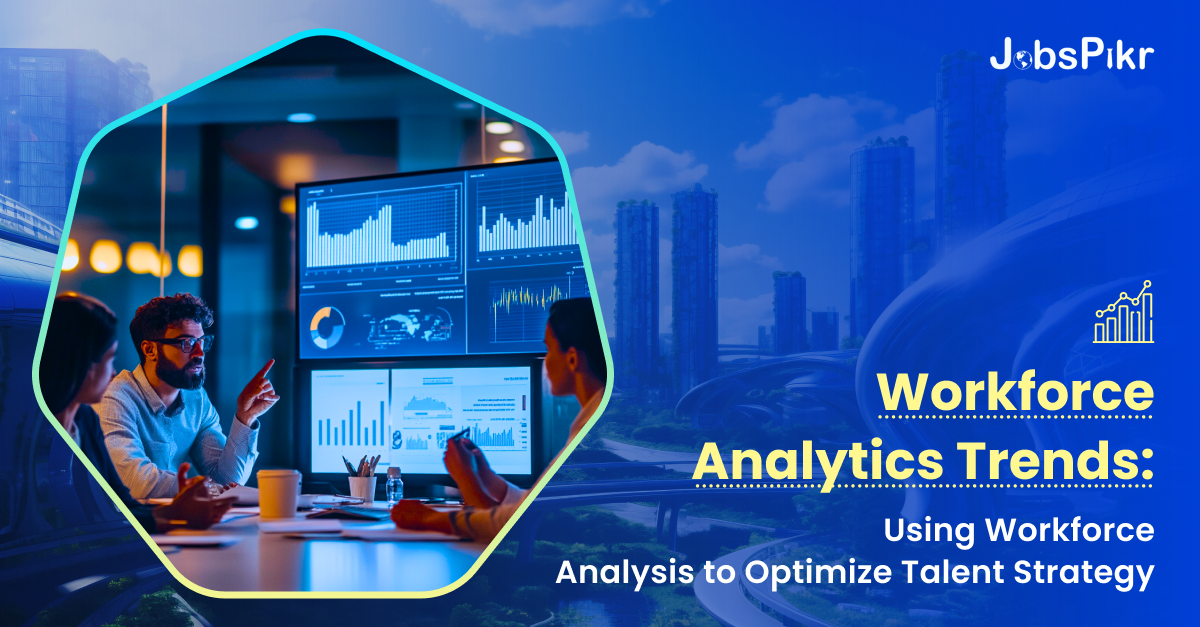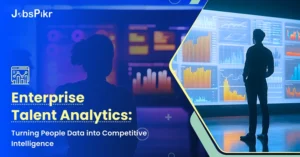Today’s workforce landscape is changing fast. With businesses facing everything from skills shortages to digital disruption, having accurate, real-time workforce data is no longer optional—it’s essential. More companies are turning to workforce analytics trends not just to track hiring metrics, but to deeply understand what drives performance, where talent gaps exist, and how they can build future-ready teams. This shift is fueled by the rise of powerful analytics tools that give clear insights into workforce behavior, labor trends, and evolving skill needs.
This article explores the top trends in workforce analytics, the growing role of predictive technologies in strategic talent planning, and how organizations are integrating real-time labor market data into their decision-making processes. Whether your focus is on hiring, reskilling, or retention, understanding and applying the right workforce planning metrics is essential for business success.
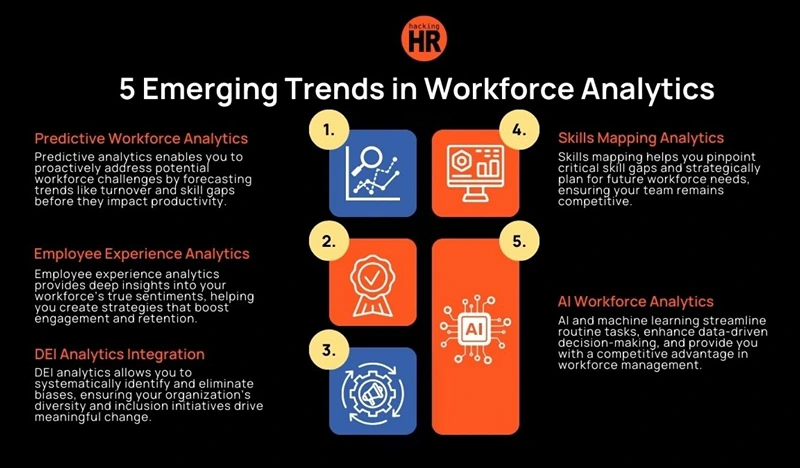
Workforce Analytics in a Data-Driven Era
Workforce analysis refers to the systematic collection, interpretation, and application of data related to human capital. It supports better planning, forecasting, and strategic alignment by turning people data into actionable business intelligence.
Workforce analytics includes:
- Headcount and turnover trends
- Skills inventories and gaps
- Compensation benchmarks
- Talent pipeline health
- Time-to-hire and cost-per-hire
Organizations using workforce analytics report 3x greater effectiveness in workforce planning and 2x better talent retention outcomes (Source).
Top Workforce Analytics Trends Reshaping Talent Strategy in 2025
With digital transformation accelerating, several key trends are redefining how organizations use analytics to build competitive and resilient workforces.
Predictive Analytics for Proactive Planning
Companies are using historical data and machine learning algorithms to forecast talent needs, attrition risks, and succession gaps. This trend helps HR teams move from reactive decisions to forward-looking strategy.
Skills-Based Workforce Mapping
Organizations are shifting from job-title-based planning to skills-first strategies. By analyzing skills inventories and adjacency models, they can plan reskilling, redeployment, and talent acquisition more effectively.
Integration of Labor Market Intelligence
Advanced enterprises are incorporating real-time external workforce data—such as regional hiring demand, wage inflation, and talent availability—to supplement internal insights.
DEI Analytics for Equitable Growth
Inclusion metrics like pay equity, promotion parity, and workforce diversity are now core components of workforce analytics dashboards to drive ethical and balanced decisions.
Continuous Listening and Sentiment Analysis
Using AI-powered tools, companies are monitoring employee sentiment and engagement trends to proactively address morale issues, burnout, and cultural alignment.
The Strategic Role of Workforce Analysis in Talent Optimization
Workforce analysis enables HR and business leaders to align talent capabilities with enterprise goals. It also helps optimize resource allocation, reduce inefficiencies, and manage organizational risk.
Strategic Hiring Decisions
- Identifying under-served talent pools and emerging job roles.
- Assessing time-to-hire vs. talent ROI.
- Balancing full-time and contingent hiring strategies.
Reskilling and Upskilling Programs
- Targeting critical skill gaps through internal learning paths.
- Forecasting future skill needs based on industry shifts.
- Tracking learning completion and performance improvement over time.
Improving Talent Retention
- Analyzing attrition trends by team, role, and geography.
- Predicting turnover risk and early warning signals.
- Customizing benefits and engagement strategies to high-risk groups.
Workforce Planning Metrics That Drive Business Value
To move beyond basic reporting and generate real impact, organizations are now focusing on actionable metrics that directly influence outcomes.
Key workforce planning metrics include:
- Revenue per employee: Aligns workforce capacity with financial targets.
- Workforce productivity index: Measures output across teams and functions.
- Succession coverage ratio: Evaluates leadership pipeline strength.
- Internal mobility rate: Tracks talent redeployment effectiveness.
- Time to productivity: Measures onboarding success and ramp-up times.
- Learning agility score: Evaluates the speed of reskilling efforts.
These KPIs help HR executives tie workforce strategy directly to operational and financial performance.
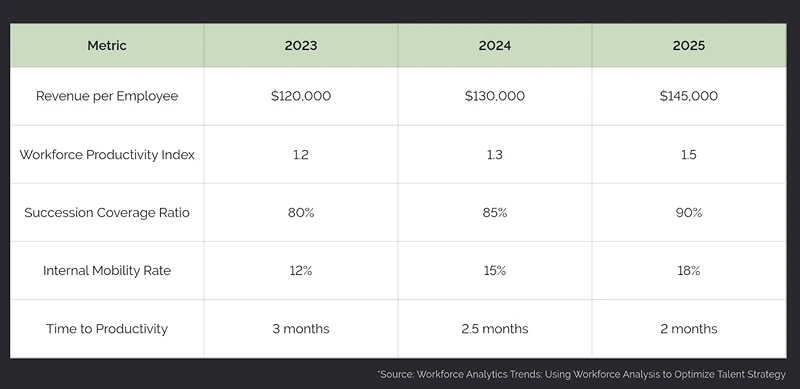
Emerging Use Cases of Workforce Analytics
As workforce analytics matures, organizations are expanding its applications across HR and business functions. Below are some of the most promising emerging use cases transforming enterprise outcomes (Source).
Workforce Scenario Planning
With economic volatility and shifting labor dynamics, scenario planning is becoming essential. Analytics platforms now allow companies to simulate workforce changes under various conditions, such as business growth, regulatory changes, or supply chain disruptions.
Diversity Heatmaps and Inclusion Insights
Workforce analytics tools now offer geographic and demographic breakdowns of diversity metrics, enabling organizations to target inclusion efforts where they’re most needed and track improvement over time.
Productivity Prediction Models
By linking performance data with engagement metrics, HR teams can proactively identify productivity dips and intervene before they affect business outcomes. Predictive alerts help leaders manage workload and well-being in real time.
Strategic Location Planning
Companies are using workforce data to decide where to open new offices or teams. By comparing labor availability, wage trends, and hiring competition across geographies, analytics informs smarter expansion and relocation strategies.
Compensation Benchmarking for Retention
Organizations are increasingly integrating salary benchmarking data to assess competitiveness and reduce attrition. This supports equitable pay strategies while ensuring alignment with evolving job market conditions.
These emerging use cases demonstrate how workforce analytics is evolving from a reporting function into a strategic capability that empowers smarter business decisions across the enterprise.
Building a Scalable Workforce Analytics Framework
Implementing a successful workforce analytics strategy requires more than dashboards. It involves governance, collaboration, and the right tools.
Steps to build a scalable framework:
- Establish data governance: Ensure accuracy, standardization, and privacy.
- Break silos: Integrate data from HR, finance, operations, and L&D.
- Invest in tools: Use platforms like JobsPikr for real-time workforce intelligence.
- Build analytics skills: Upskill HR teams in data storytelling and visualization.
- Tie analytics to outcomes: Define success metrics and use insights to guide business decisions.
A scalable framework not only supports immediate talent strategy but also drives long-term agility and adaptability.
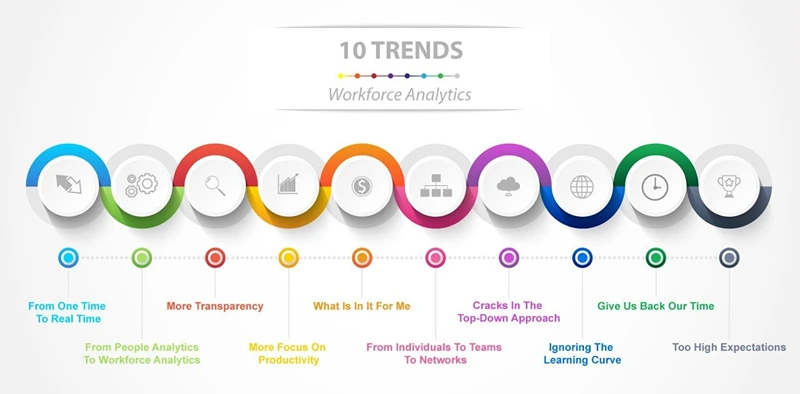
Lead the Future of Work with Workforce Trend Analysis
Workforce analytics is no longer a luxury—it’s a mission-critical function for enterprises that want to stay ahead of disruption and lead with talent. As 2025 ushers in new challenges and opportunities, organizations that embrace advanced workforce analysis and monitor emerging workforce analytics trends will be better equipped to manage talent proactively, build resilient teams, and scale with precision.Sign up with JobsPikr today to access real-time labor market analytics and workforce data intelligence tools that help you make faster, smarter workforce decisions.
